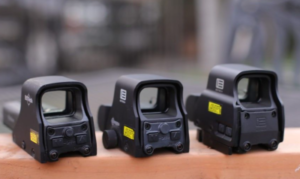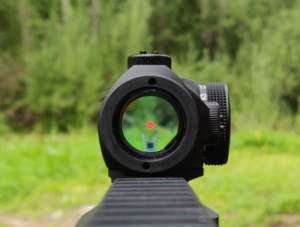Red Dots vs Holographic Sights!
The advancements in technology in the optics industry have made a lot of things possible. For civilian shooters, advances in optics have made them move beyond the standard iron sights systems into more advanced electronic sighting systems.
Red dot and holographic sights are two popular types of optical sights used by firearm enthusiasts, hunters, and military personnel. These sights are designed to provide quick and accurate target acquisition and enhance shooting accuracy in a variety of situations.
While both types of sights use a similar principle of projecting a reticle onto a lens, they differ in their underlying technology, construction, and operational characteristics.
Today, the most popular sighting systems are red dot and holographic sights. Red dot sights generate a dot-shaped reticle that is either green or red to serve as the point of aim when shooting. They are very easy to use and ideal for use in virtually all lighting conditions.
Adding a red dot or holographic sight on your firearm comes with a multitude of benefits. Firstly, you are guaranteed speedy target acquisition in all scenarios. A red dot sight will also improve your point of aim and fine-tune your accuracy.
If you are in the market for the best optic for your civilian shooting and home defense needs, you are more likely to boil that decision down to either a holographic sight or a red dot sight
This article will explore the key differences between red dots and holographic sights, their advantages and disadvantages, and which one may be better suited for your shooting needs.
Holographic Sights

Holographic sights are also known as holographic diffraction sights. These sights use a laser-transmitted hologram which provides a solid reticle to the user.
During use, the laser doesn’t get reflected into your eye. Instead, it is projected on top of the target you are shooting where it provides a precise point of aim.
Generally, holographic sights have a semi-square shape with a rectangular viewing window. This window provides a great field of view. If you care a lot about fast target acquisition, you will find the large field of view helpful.
Another outstanding facet of holographic sights is the solid construction. These sights are crafted from premium-quality materials to offer unmatched durability. They are also shockproof to stand up to high recoil and weatherproofed to be operable under any weather condition.
Furthermore, holographic sights produce stunning reticles, but not without using lots of power. The laser technology used in holographic sights limits them to about 1500 hours of battery life before you do a battery replacement. This makes them more expensive to run and maintain, especially for those who use them on daily basis.
When it comes to size and weight, holographic sights are typically larger and heavier than their red dot sights counterparts. However, the weight is manageable so you don’t have to worry about the sight adding extra bulk to your firearm and affecting its balance.
Top-of-the-line holographic sights are more expensive compared to red dot sights. You will have to pay over $400 for a single unit depending on the features it has and the brand it comes from.
Pros
- Great field of view. Holographic sights are known for the wide field of view they provide. With the wide field of view, you will be able to aim with both eyes open and enhance your situational awareness.
- Stunning reticle visibility in all light settings
- Ideal for use with magnifiers. A holographic sight is better suited for use as a second optic with magnifiers.
- Great tool for real-world scenarios. Holographic sights are designed to work even when the front lens is broken.
- Some top-tier red dot sights are designed to perform rangefinding duties
Cons
- Shorter battery life
- Heavier and bulkier than red dot sights
- More expensive
Red Dot Sights

A red dot sight is a sighting system that uses a red/green dot reticle as the aiming point. This sighting tool uses an LED to project bounces back to the shooter’s eyes by the front glass.
Unlike holographic sights that are non-magnified, red dot sights have true 1x magnification. The benefit that comes with this magnification is an unlimited field of view for rapid target acquisition. Some red dot sights also allow for both eyes open shooting which increases your awareness in the field.
With red dot sights, the reticle size varies from one product to the other. Measured in MOA, red dot sights with not more than 3 MOA reticle sizes are the best for fine-tuning your accuracy.
These reticles are so small to obstruct the target and they offer the best balance between speed and precision. On the other hand, models with large reticle sizes are the best for users with aging eyes.
Another outstanding thing about red dot sights is the long battery life. With the low power-consuming LED technology, most red dot sights will operate continuously for about 50,000 hours which is equivalent to 5 years.
Furthermore, the simple technology used in red dot sights allows manufacturers to easily make compact and lightweight optics. This way, it is easy to find a miniature red dot sight that fits easily into handguns, whereas there is no holographic sight for handguns.
Above all, red dot sights are available at various price ranges for you to pick a model that matches your budget.
Pros
- Ease of use. A red dot sight places the target and the reticle on the same plane. This gives you a single point of focus which makes them easy to use, even for beginners
- The simple technology used in red dot sights makes them one of the most affordable optics out there
- Compact size and lightweight design
- Multi-platform friendly. Most red dot sights are built to be mounted on a wide range of firearms
- Improved accuracy. Adding a red dot sight on your firearm will boost your target acquisition speed and hone your accuracy
Cons
- Red dot sights lose zero easily in rugged hunting conditions
- Red dot sights are ideal for close-range applications only
Similarities Between Red Dot Sights and Holographic Sights
- Both are night vision compatible. Most holographic and red dot sights have night vision brightness settings for use with night vision devices
- Both types of optics are designed to be primarily used at close ranges
- Both sighting tools have electronically powered reticles which in most cases are battery powered
Conclusion
When comparing red dots vs holographic sights, it is hard to say that there is a clear-cut answer as to which sighting tool you should choose. This is because our needs are different and what works for your neighbor might not work for you. Factor in the activity you will be using the sight for and decide accordingly.
Related
- Red Dot Vs Holographic Vs Prism
- 8 Best Red Dots for 10/22 Takedown,Carbine & Steel Challenge
- 5 Best Red Dots for Hellcat Pro
- 8 Best Red Dots for Walther PDP
- 6 Best Red Dots for Heavy Recoil
- 5 Best AR-15 Red Dots with Night Vision
- 5 Best Vortex Red Dot Sights
- 6 Best Red Dot Sights for Glock 43x Mos
- 6 Best Red Dots for Concealed Carry
- 6 Best Red Dots for Sig P365 SAS
- 5 Best Red Dots for Benelli M4

